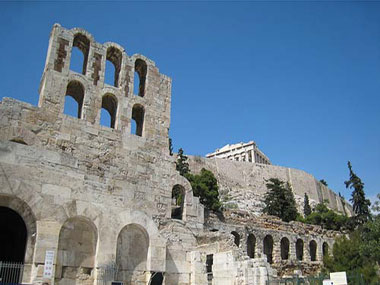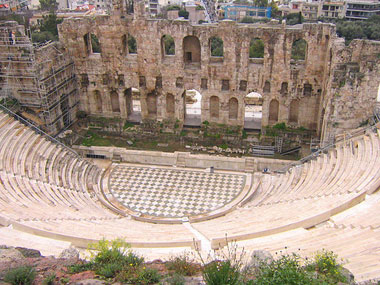Herodes Atticus Theater - Dionysus Theater : The Southern Slope of the Acropolis
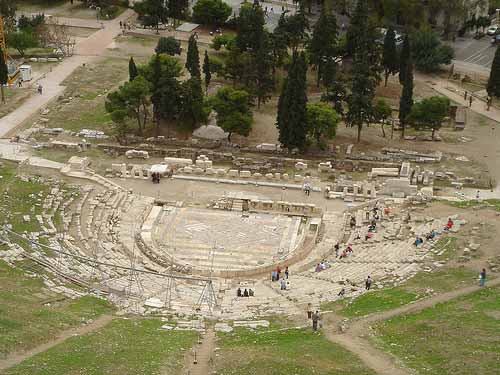
This was the cultural center of ancient Athens. The first Pan-Hellenic and global role model for the infrastructural synthesis in united complexes of art and exhibition sites.
Dionysus' Theatre: this is the birthplace of tragic poetry, the first theatre of the western world which is created inside the holly shrine of the Greek God Dionysus. In 540 BC an archaic temple is built which contains the statue of the god. During the 4th century BC the classic temple of Dionysus is built and his chryselephantine statue is created by Alkamenes.
In the end of the 6th century BC we have the creation of the theatre around the primary circular orchestra that pre-existed and is barely noticed today among the ruins of the stage. In this theatre the plays of Aeschylos, Sophocles, Evripides and Aristophanes were presented in front of an audience for the first time. Their works are still an inspiration to many people.
In 333 BC the politician and orator Lykourgos builds the stone gradins. The theatre had a capacity of 17000 visitors and when the surroundings were full it could host up to 30000. The ancient Peripatos (walkway) divided the theatre in two parts. During the times of Neronas (67 AC) the scene and orchestra take the Roman form kept until today.
To the east of the Dionysian theatre there was the renowned Odeon of Pericles which is wrecked today. It was built during the 5th century BC with the masts of Persian ships taken from the sea battle of Salamina island in 480 BC and was used for the musical auditions of the Athenians. According to Vitrouvios the Odeon was burned during the war with Mythridates and then rebuilt from Ariovarzanis, the king of Kappadokia.
Above the theatre was the choragic monument of Thracyllus (319 BC). During the Christian years it is transformed into the church of Our Lady Chrysospiliotissas. A bit higher two Corinthian pillars are saved which were used as the base of choragic tripods during the Roman years.
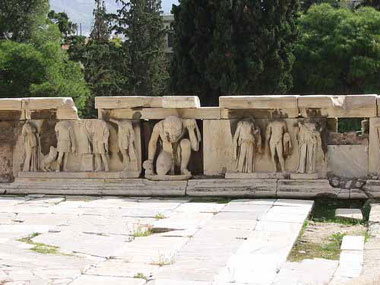
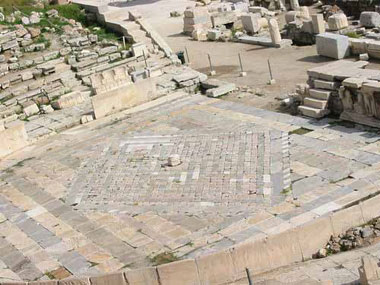
To the west of the theatre there is what was left from the ancient Asclepieion. The altar of the God of medicine, Asclepios was founded in 420 BC and operated as an altar, practice, sanatorium and school of medicine.
Between the Asclepieion and the Herodion there were other monuments, ruined today, such as the grave of Ippolytos, the ancient fountain and the altars of Earth Koutroforos, Demeter-Chloe and Aphrodite Pandimos.
Right below the Asclepieion and the walkway is saved what is left from the Archway of Evmenos which functioned for the service of spectators of the Dionysian theatre and later for the audience of the Odeon. The two-story building was built with a donation by king Evmenis of Pergamos the second (197-160 BC).
The Odeon of Herodes Atticus: it is situated right next to Evmenis' archway and although it was built four centuries later, in 160/1 AC, from Herodes Atticus in the memory of his wife Rigilli, it is harmoniously coexisting with the archway. It was monumental and luxurious and it was covered by a roof made of cedar wood. It was set on fire by the Erouli in 267 AC and during the Ottoman rule it was accumulated to the wall of Chasekis, along with the archway of Evmenis, and became the unconquerable Serpentzes. The Odeon can host up to 5000 people and today it is used for musical and theatrical performances.
